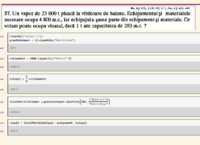btimofte100
New member
- Joined
- Aug 22, 2020
- Messages
- 30
Hi all
I have the problem
"A ship has 23 000 metric tonnes and goes whale hunting . Equipment and materials occupy 4800 cubic meters and the crew 1/6 of the equipment and materials . Whats the volume of the hunted whales if one metric tonne has capacity of 283 cubic meters ?"
The book says 909 cubic meters as answer but i have no CLUE how did they get to this value
Is there a error in the book or the answer is correct ?
I have the problem
"A ship has 23 000 metric tonnes and goes whale hunting . Equipment and materials occupy 4800 cubic meters and the crew 1/6 of the equipment and materials . Whats the volume of the hunted whales if one metric tonne has capacity of 283 cubic meters ?"
The book says 909 cubic meters as answer but i have no CLUE how did they get to this value
Is there a error in the book or the answer is correct ?
Last edited:

